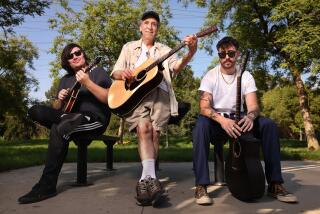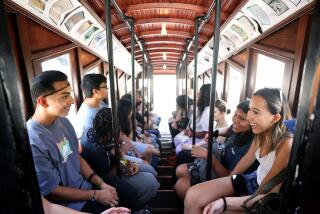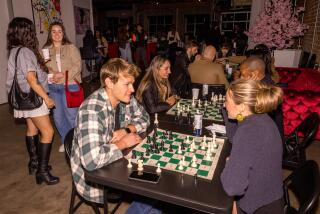Bridging the Generations : Teens Take to Complex Card Game Associated With Over-30 Crowd
NORTH HOLLYWOOD — Two years ago, Joshua Solomin thought bridge was an insipid card game that entertained gray-haired nursing home residents, certainly not a game for an Internet-surfing teenager.
Now, the 18-year-old Stanford freshman finds himself scouring his college dorm for bridge partners.
“I never expected that [bridge] was something that would appeal to me and my group of high-school-aged friends,” Joshua confessed. “But I really like it now.”
Joshua’s penchant for bridge began 1 1/2 years ago at North Hollywood High School, where a history teacher’s casual offer of a bridge lesson to relax some students after an Advanced Placement test led to the creation of a campus bridge club with Solomin as a founding member.
“When you read about high schools in the paper, you don’t hear, ‘Yeah, this high school is known for its Academic Decathlon team and its bridge club,’ ” Joshua joked. “But we thought it’d be fun.”
While most high schools plug chess as the intellectual extracurricular activity of choice, North Hollywood is among a smattering of schools around Los Angeles that are starting to bequeath the benefits of bridge to students.
“You really have to understand your partner and you have to think hard to pull together a plan, which is fun,” said North Hollywood sophomore Lily Lam, who learned to play in September. “Plus, it’s another excuse to hang out with friends.”
At a recent lunch-hour game on campus, absent was the sedate sipping of coffee or tea that’s gone hand-in-hand with the game. Instead, students slurped ramen noodles and munched Doritos as they scattered themselves around clusters of mismatched desks, dealt decks of cards adorned with Bugs Bunny, the Tasmanian Devil and Marvin the Martian.
“Taz is the best,” one student opined, asserting his allegiance to the hairy animated tornado.
“No, it’s the Martian,” another student countered. “The Martian is the coolest.”
Just a few feet away, Lily and three other students ignored the Looney Tunes debate and studied their cards. Sophomore Esther Kim and her partner, senior Ann Wang, eyed their hands and then each other before Esther started the bidding.
“Pass,” said Esther.
Then Lily: “Pass.”
Pause. “Pass,” said the fidgeting Ann, uncomfortable with the cards she had and how to play them.
There were two more passes with students declining to make a bid before it got back around to Lily.
“One diamond,” she said. With that the strategic bidding process began.
Lily’s offer accomplished two things--it told her partner she had enough diamonds in her hand to bid that suit, and it showed she had enough high cards to bid. But her partner, Vincent Gu, couldn’t respond to her bid the way she had hoped. Eventually, it was Esther and Ann who were the high bidders and established the “contract” necessary to win coveted points.
If only a handful of public schools in Los Angeles have bridge clubs, even fewer have clubs registered with a national organization that enables students to compete in tournaments. North Hollywood High and Saddleback High School in Orange County are the only area schools registered with the American Contract Bridge League, which sponsors competitions and oversees most official bridge clubs.
At both schools, it was bridge-playing teachers who decided to spread the game’s message of memory, math and moxie.
“At first the students were intrigued, but thought it was a strange idea when I suggested teaching them bridge,” said Kailim Toy, a North Hollywood High School history teacher who’s been playing the game for more than 25 years. “But it kind of clicked for several of them.”
Joshua was neutral at first. “I thought, ‘OK, I don’t have to take notes, so that’s cool.’ Then by the end of an hour I was pretty much hooked,” he said.
Card games were already popular at North Hollywood. Games like gin, Hearts, Spit or Japanese poker were played during lunch or after classes. But bridge won hands down, and last fall students sought Toy’s help to become an official club to meet regularly and attract more members.
Similarly, the private Brentwood School started a bridge club in September, Eagle Rock High School is hoping to revive the bridge club it had last year, and El Camino Real High School in Woodland Hills started its club last week.
Just as chance has little role in a well-played game of bridge, the sudden flurry of high school bridge clubs is no coincidence. It reflects the efforts of Tony Greenberg, a Malibu pediatrician who heads the Los Angeles chapter of the American Contract Bridge League.
“As [kids] get into bridge, I think they realize how much fun it is, how challenging it is and how overwhelming the complexities are,” said Greenberg, who has been calling city schools with the offer of providing official bridge teachers to instruct students.
“The problem is few kids get involved with it because many still think it’s an old-fogy game,” he said.
The average age of league members is 66, part of the generation in college during the ‘50s, when bridge was big. The game’s popularity faded during the late ‘60s and it never gained momentum again among young people. No one is clear on the reason--the game simply slipped out of fashion.
In the year that North Hollywood senior George Lee has been playing bridge, he’s competed in a half-dozen tournaments--winning a few--and each time there was at least a 40-year gap between George and the next-youngest player.
“At first it’s kind of intimidating,” George said, “but then you kind of get used to it. And most of the older people are pretty glad to see some young faces. It’s something new for them.”
For George, who held a bridge workshop last summer at the Northridge library, the game is all about communication, body language and strategy.
“The people I regularly play with like to get into the more complex aspects of the game, and that’s when it really gets interesting,” he said.
At North Hollywood, George plays with only one partner, sophomore Raymond Tsai. George taught Raymond the game’s strategies and, over the past several months, the two have developed a subtle communication that has overwhelmed much of their competition.
“If you really play the game well,” said Raymond, “when the first card is tossed you can just sit there for a minute and concentrate and you can figure out your plan for the entire game. That’s what’s so cool about the game.”
Bridge is primarily a game of skill, with a little bit of luck depending on which version you play. The game, which has its roots in 16th century England, is similar to spades but requires more logic, a knowledge of probability and deft communication with one’s partner.
While North Hollywood High’s bridge club certainly isn’t the school’s most popular group, it has amassed a respectable following. About 30 students meet every Friday at lunch in Toy’s classroom to partner up and play.
At a table in the center of the room, Raymond, 15, took his regular seat across from George.
On this day, the duo played against sophomores Grace Lee and Raymond Zimmer. The moment the cards were dealt for a last round, George and Raymond began assessing their opponents’ cards--and each other’s--with pointed stares and slowly drawn-out bids where each inflection was packed with meaning.
“I’lllll biiiiiiid six hearts,” George drawled, meaning he and Raymond would have to collect 12 of the 13 tricks or a small slam.
Their opponents were incredulous. “What’s going on here?” Grace asked with darting looks from her partner to George and Raymond. “Why didn’t you just bid seven hearts?”
They didn’t answer. As the bell marking the end of the period rang, George and Raymond slapped down their cards.
“If you have the king of diamonds, then we’ve won because I’ve got these tricks and [Raymond’s] got a couple of trumps,” George told a bewildered Raymond Zimmer.
Zimmer did have the king of diamonds. He threw up his hands, picked up his backpack and left for his class.


